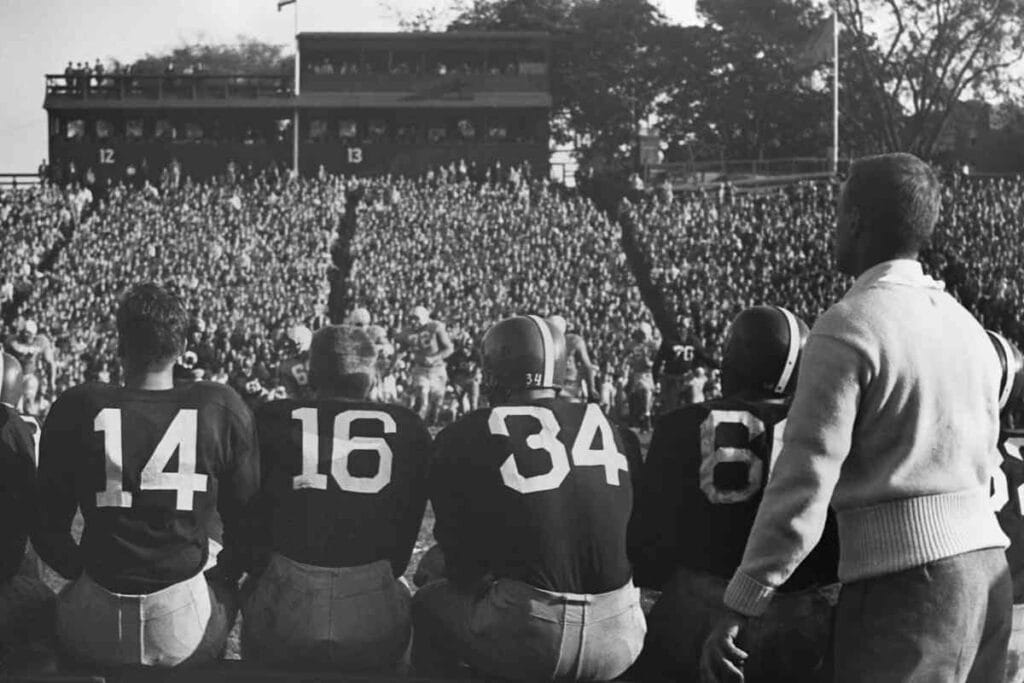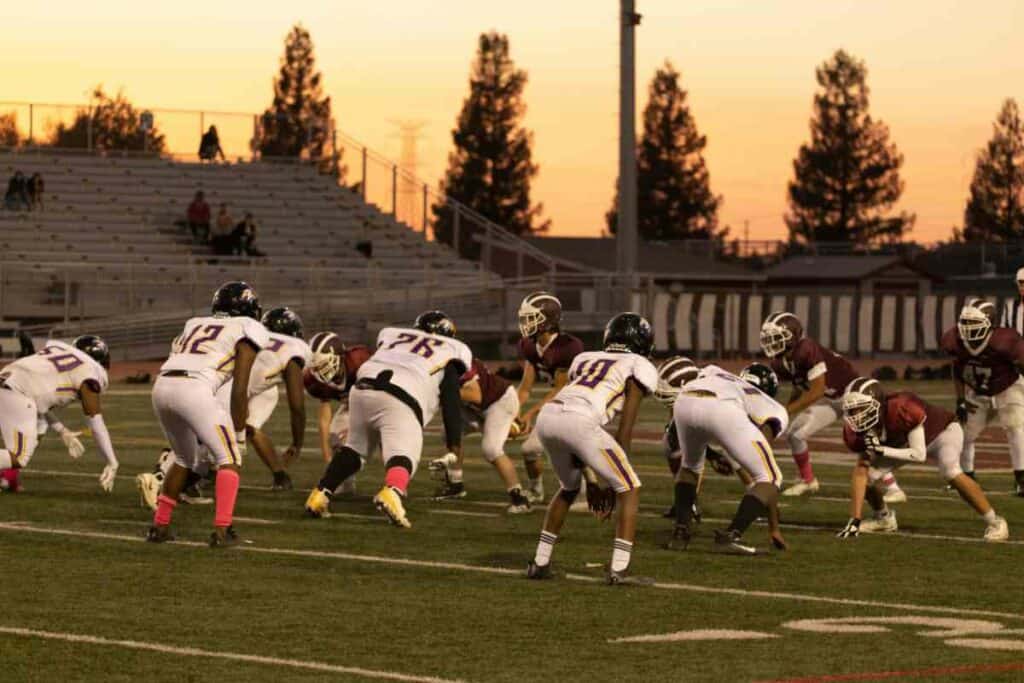Who Invented American Football: A Brief History
American football has a deep history, starting from games played in England to the big matches in the U.S. today. From its English ancestors to its modern American evolution, discover the figures and innovations that shaped its unique character. Ever wondered how soccer and rugby contributed to the birth of the NFL?

Be prepared this football season by brushing up on how football betting works.
Who invented football?
American football originated from English soccer and rugby in the mid-19th century. While these sports influenced its early form, American football’s distinct evolution occurred in the U.S., especially within universities. Walter Camp, considered the “Father of American Football,” made significant contributions to its unique rules and gameplay.
The Birth from Soccer and Rugby American football, an iconic sport deeply ingrained in North American culture, traces its lineage back to two traditional English sports: soccer (often referred to as association football) and rugby.
These two sports emerged from various forms of football games played in the United Kingdom during the mid-19th century. In these ancestral games, a ball would either be kicked toward a goal or over a line.
These early variations, steeped in English public school traditions, have evolved from even older medieval ball games. The imprint of soccer and rugby on American football is evident in its rules and gameplay style.
University Campuses: The Birth of American Football
The foundation of American football was laid at universities across North America, especially within the United States, as the 19th century drew to a close.
Many students, influenced by English and Canadian immigrants, took up the sport with enthusiasm. Marking a milestone in sports history, the first intercollegiate football match took place on November 6, 1869, featuring teams from Rutgers and Princeton.
The Dawn of Football Associations
To bring order and structure to this budding sport, the Intercollegiate Football Association (IFA) was established in 1873. It set down the initial rules and guidelines for American football.
As the game grew in popularity and scope, the IFA made way for the Intercollegiate Athletic Association of the United States (IAAUS) in 1906. Within a few years, in 1910, the IAAUS was rebranded as the now globally recognized National Collegiate Athletic Association (NCAA).

Milestone Matches
The Boston and McGill University Games In the evolution of American football, the 1867 Boston Game holds a significant place.
This match, contested between Harvard and McGill University, was an amalgamation of soccer and rugby rules and was played using a round ball. Not only did it permit ball carrying, but it also laid the groundwork for modern American football.
Building on this, in 1874, another pivotal game took place. McGill University from Montreal, Canada, squared off against Harvard. This game leaned more towards rugby than soccer.
Heralded as the inaugural true American football match, it incorporated a rugby ball, introduced the concept of a line of scrimmage, and was the first to implement the system of downs.
American football’s origins can be traced back to English traditions, but its growth and development are uniquely American stories, fueled by the passion and innovation of its early adopters.
Walter Camp: The Architect of Modern American Football
Redefining Gameplay: The Introduction of Downs and Scrimmage Often hailed as the “Father of American Football,” Walter Camp’s influence on the sport during the late 19th and early 20th centuries was profound. Among his groundbreaking contributions, the introduction of the downs system stands out.
Before Camp’s innovations, football teams had unlimited attempts to move the ball forward, either by carrying or kicking. Camp transformed this by introducing a structure: teams now had four attempts to advance the ball a set 10 yards. Not only did this infuse the game with strategy, but it also heightened its suspense.
Replacing the unruly scrum of yesteryears, Camp introduced the scrimmage. This involved players lining up against each other on either side of a designated line of scrimmage, initiating the play with a snap.
This systematized approach to play made the game not only safer but also laid the foundation for specialized roles, the most notable of which was the quarterback.
Revamping Scoring: Touchdowns, Field Goals, and Safeties Camp wasn’t just content with reforming gameplay; he also revolutionized football’s scoring system.
Previously, teams garnered points by moving the ball over the opponent’s goal line.
Camp, however, brought in the concept of touchdowns, offering six points for successfully carrying the ball into the end zone. He didn’t stop there – the field goal, which earned three points for a successful kick between the goalposts, and the safety, awarding two points for tackling an opponent within their end zone, were his brainchildren.
The Dawn of the Quarterback
Before Camp’s era, the onus of calling plays and managing the ball rested on the team captain. Recognizing the need for specialization in football positions, Camp conceptualized the role of the quarterback.
This pivotal position, responsible for orchestrating plays and handling the ball, added depth, complexity, and strategy to the offensive game.
Spotlight on Talent: The All-American Team
Further cementing his legacy, Camp is credited with the creation of the All-American Team. Starting in 1889, this selection highlighted the crème de la crème of college football talent. Beyond recognizing outstanding players, the All-American Team amplified the prestige of college football, bolstering its appeal nationwide.
To summarize, Walter Camp’s transformative ideas not only modernized American football but also positioned it as a thrilling sport celebrated across generations.
American Football’s Journey: From Rugged Beginnings to the Modern Field

The Game Changer: Introduction of the Forward Pass
From its 19th-century origins, American football has witnessed considerable evolution, but few changes were as transformative as the introduction of the forward pass.
Before this momentous change in 1906, football was predominantly a ground game, where brute strength dictated the flow. The advent of the forward pass turned the tables, allowing teams to throw the ball downfield.
This not only diversified offensive maneuvers but also brought an added layer of excitement and unpredictability to the game.
Safety First: Revisions in Tackling and the Role of Penalties
As the game matured, so did the methods of play. Historically, tackling in football was notably aggressive, with players often using their heads as battering rams, risking severe injuries.
Today’s football emphasizes safer techniques, encouraging players to securely wrap around the opponent rather than strike with excessive force
Accompanying this shift in tackling, penalties have evolved too. Modern football, with its emphasis on player safety and sportsmanship, has seen a rise in penalties targeting dangerous hits and unsportsmanlike behaviors, ensuring a safer and more respectful playing environment.
The Pinnacle of Professionalism: The Ascendance of the NFL
The influence of professional football leagues, especially the National Football League (NFL), on the game’s evolution is undeniable. Originating as the American Professional Football Association in 1920, the league metamorphosed into the NFL.
Today, it stands as a global juggernaut, making it not just the most-watched sports league in the U.S., but also a cultural powerhouse. Events like the Super Bowl are more than just games—they’re cultural spectacles.
Moreover, the NFL’s proactive approach has led to pivotal changes in the game’s rules, from integrating instant replays for better decision-making to refining overtime rules for a fairer contest.
In essence, the story of American football is one of constant evolution, shaped by innovative rule changes, player safety concerns, and the influential hand of professional leagues, ensuring the game remains as exhilarating as ever.
| Entity | Impact on Evolution of American Football |
| Forward Pass | Revolutionized the game, opened up new offensive strategies |
| Tackling | Became less violent, focused on safety |
| Penalties | More prevalent, cracking down on dangerous hits and unsportsmanlike conduct |
| Professional Football | Shaped the rules of the game, introduced instant replay and changes to overtime rules |
| American Professional Football Association | Founded in 1920, later became the NFL |
| American Football League | Merged with the NFL in 1970 |
| NFL | Most popular and profitable sports league in the world |
| Super Bowl | Cultural phenomenon, one of the most-watched television events in the world |
| George Halas | Co-founder of the NFL, instrumental in shaping the league |
American Football: A Global Phenomenon and Commercial Powerhouse

From Grassroots to Billions: Commercialization and its Audience
The meteoric rise of American football from its humble beginnings to becoming a commercial titan is nothing short of astonishing. With annual revenues reaching into billions, it’s evident that the sport isn’t just about the game anymore – it’s a business powerhouse.
The National Football League (NFL), as a testament to its mammoth growth, boasts an estimated valuation exceeding $100 billion.
This commercial success has significantly boosted the sport’s viewer base. Whether it’s through television broadcasts or the electrifying atmosphere of live games, millions of fans worldwide are captivated by American football’s thrilling spectacle.
Catalyst for Other Sports
The allure of American football isn’t just confined to its pitch; its influence permeates other sports domains, especially within the United States.
The resounding popularity of football has indirectly propelled the growth of sports like basketball, baseball, and ice hockey. Furthermore, American football’s rigorous training regimes have found their way into track and field disciplines, where athletes harness these techniques to enhance their performances.
Beyond Borders: American Football’s Global Footprint
While American football’s heartland remains the United States, its allure has transcended international boundaries. Nations across Europe and Asia have embraced the sport, with burgeoning leagues and growing fanbases.
Recognizing this global appetite, the NFL has ventured beyond American shores, hosting games in diverse locales from London to Mexico City. These international forays not only spotlight the sport’s universal appeal but also solidify its place in the global sports pantheon.
In summary, American football, beyond its on-field drama, stands as a testament to how a sport can evolve into a cultural and commercial behemoth, influencing numerous other domains and finding resonance with audiences across the globe.
| Entity | Impact |
| Television | American football’s popularity has led to the growth of television networks dedicated to covering the sport, such as ESPN and NFL Network. |
| World War I | American football played a role in World War I, with many college football players enlisting in the military and playing football for their units. |
| Violence | American football has been criticized for its violent nature, with concerns about player safety and the long-term effects of concussions. |
| Basketball | American football has influenced the development of basketball, with many basketball players using football-style training techniques to improve their performance. |
| Baseball | American football has also influenced the development of baseball, with many baseball players using football-style training techniques to improve their performance. |
| Ice Hockey | American football has influenced the development of ice hockey, with many ice hockey players using football-style training techniques to improve their performance. |
| Soccer-style game | American football has its roots in games that were similar to soccer, such as “mob football” and “rugby football.” |
| Rugby football | American football evolved from rugby football, which is still played in many countries around the world. |
| Canadian football | Canadian football is similar to American football, with some minor differences in rules and gameplay. |
| Modern football | American football has evolved significantly since its inception, with changes to rules, equipment, and gameplay. |
| College football | College football is a major part of American football culture, with millions of fans tuning in to watch games each year. |
| NCAA | The National Collegiate Athletic Association (NCAA) is the governing body for college sports in the United States, including college football. |
| College Football Hall of Fame | The College Football Hall of Fame is located in New Britain, Connecticut, and honors the greatest college football players and coaches of all time. |
| Daily Dozen | The Daily Dozen was a set of exercises developed by the US military during World War I, which included football-related exercises such as “passing the ball” and “tackling.” |
| Crew | Crew is a sport that is similar to rowing, and football-style training techniques have been used to improve performance in the sport. |
| Swimming | Football-style training techniques have been used to improve performance in swimming, particularly in the area of strength and conditioning. |
| Tennis | Football-style training techniques have been used to improve performance in tennis, particularly in the area of footwork and agility. |
Pioneers of American Football

John Heisman: Architect of the Dynamic Game
A pivotal figure in American football’s formative years, John Heisman left an indelible mark with his aggressive and pioneering tactics. Among his myriad contributions, Heisman’s advocacy for the forward pass stood out, transforming football into a more thrilling and strategic spectacle. His visionary introduction of the downs system further enhanced the game’s pace and competitiveness.
Amos Alonzo Stagg: Ambassador of Football’s Spirit
Embodied in Amos Alonzo Stagg was the quintessential football evangelist. As both a player and a coach, Stagg broadened the game’s appeal, making it more relatable to the masses. His coaching methodology, accentuating teamwork and strategic depth, became foundational to modern football. Significantly, Stagg’s vision led to the evolution of the lineman position, cementing its importance in today’s game.
Pop Warner: Maestro of Speed and Strategy
Pop Warner’s football legacy is underpinned by his emphasis on athleticism, agility, and speed. His coaching techniques heralded a shift in how the game was played. Warner’s introduction of the “flying wedge” – albeit controversial and eventually banned – showcased his forward-thinking approach. More enduring, however, was his contribution to honing the modern running game, a pivotal aspect of contemporary football.
Fielding H. Yost: Innovator of Offensive Brilliance
Fielding H. Yost’s stamp on football is defined by audacity and innovation. His “point-a-minute” offense not only captivated fans but also revolutionized scoring dynamics. Yost’s genius didn’t stop there. His developmental work around the center position refined its role, ensuring its centrality in modern football dynamics.
In essence, the tapestry of American football is rich and vibrant, thanks to the monumental contributions of these trailblazers. Their legacies continue to influence every snap, tackle, and touchdown we witness today.
| Key Figure | Contribution |
| John Heisman | Development of the forward pass and system of downs |
| Amos Alonzo Stagg | Popularization of the game and development of the modern linemen position |
| Pop Warner | Development of the flying wedge and modern running game |
| Fielding H. Yost | Use of the “point-a-minute” offense and development of the modern center position |
Overall, these key figures played a critical role in the development of American football, helping to shape the game into the exciting and dynamic sport that it is today.
Frequently Asked Questions
When did Walter Camp invent football?
Walter Camp is often referred to as the “Father of American football” and is credited with making significant contributions to the sport. However, he did not invent football. Rather, he helped to shape the game into what we know it as today. Camp was born in 1859 and played football at Yale University in the late 1870s and early 1880s. He went on to become a football coach and is credited with introducing many innovations to the game, such as the line of scrimmage and the system of downs.
Who won the first football game ever?
The first football game ever played is believed to have taken place in 1869 between Princeton and Rutgers. Rutgers won the game by a score of 6-4. However, it is important to note that the game was quite different from the modern version of football. The rules were not standardized, and the game was more similar to a combination of soccer and rugby.
Who invented football UK?
The origins of football can be traced back to ancient civilizations, but the modern version of the game that we know today was developed in the United Kingdom in the mid-19th century. The rules of the game were standardized in 1863 with the formation of the Football Association in England.
When was the first football game?
As mentioned earlier, the first football game is believed to have taken place in 1869 between Princeton and Rutgers. However, the first recorded game played under modern rules took place in 1863 between two teams of English schoolboys.
When was American football first invented?
American football evolved from rugby football and association football (soccer) in the late 19th century. The first intercollegiate football game was played in 1869 between Princeton and Rutgers, and the game continued to evolve over the next few decades. The modern version of American football began to take shape in the early 20th century.
Who created the NFL and when?
The National Football League (NFL) was created in 1920 as the American Professional Football Association. The league was renamed the NFL in 1922 and has since become the premier professional football league in the United States. The league has undergone many changes over the years, including the addition of new teams and the adoption of new rules and regulations.
